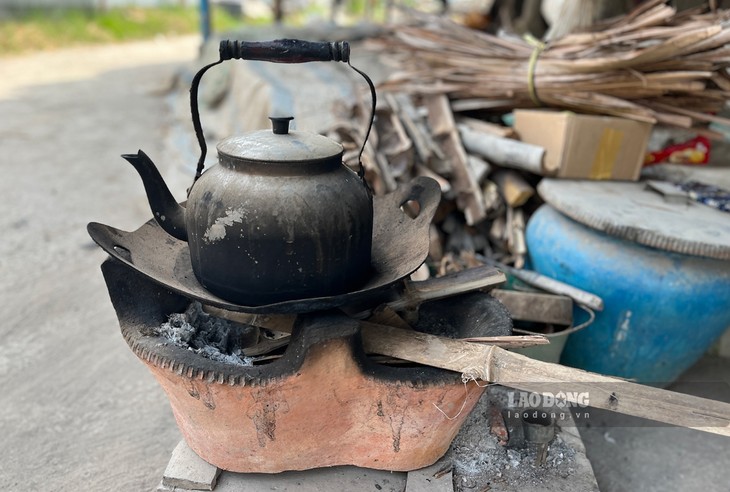(VOVWORLD) - The “ca rang”, or earthen stove, is a product of the southern region. The stove is made of clay, with three legs attached to a fire-resistant grate shaped like a figure 8 that’s used to add more charcoal without removing the wok. For 100 years Phu Tho hamlet in An Giang province has been preserving the traditional stove-making craft.
 The ca rang earthen stove is still used by many households in the southern region. (Photo: Huynh Nhi/laodong.vn) The ca rang earthen stove is still used by many households in the southern region. (Photo: Huynh Nhi/laodong.vn) |
Rows of earthen stoves drying in the sun clearly identify Phu Tho hamlet as a stove-making village. The village was once busy with boats docking to pick up stoves to be sold in Can Tho, Vinh Long, and Hau Giang.
Nguyen Van Do, the owner of a stove-making workshop in Phu Tho hamlet, said he is the third generation of his family doing this job.
“The workers who work for me are my age. I earn very little, but I still do it,” said Do.
The firebox of the stove holds plenty of firewood and ashes and is windproof, allowing a pot to be brought quickly to a boil.
There are stoves of many sizes and types, but each one goes through 18 basic steps, including mixing the soil, stepping on the clay, shaping the mold, polishing, making the tray, and – the final step – firing for at least 24 hours. The process is completely manual.
Each step is assigned to a different person and all of them must be precise. The ratio of soil, ash, rice husks, and sand is a secret formula known only to the kiln owner. The beauty of the stove is due mainly to the skilled women involved. 80% of the female workers in Phu Tho hamlet are engaged in the craft.
The prime development period of Phu Tho hamlet began when Vietnam was reunified in 1975, but its golden age was in 1979 when Phu Tho had more than 100 households engaged in making earthen stoves.
Nguyen Van An, a Phu Tho resident, says that in 1979 ca rang stoves were very popular.
“The craft has been around for 100 years. Previously, many people made a good living doing it. If the government had invested in raw materials and set up co-ops, the craft would have flourished even more,” An recalled.
On average, a worker could make up to 30 stoves a day. Each year Phu Tho hamlet sold 360,000 stoves. During Tet, the traditional Lunar New Year, local workers worked day and night to fulfill the flood of orders.
Stove maker Tran Ngoc Minh told VOV, “This was my grandfather’s traditional occupation. My father was the second generation. Now I’m the third generation. I love this craft. I don’t have enough stoves to sell during Tet. In the south, when Tet comes people often buy new stoves for the Kitchen God.”
Cà ràng stoves have gradually been replaced by gas stoves and electric cookers. The market for ca rang has shrunk. Phu Tho now has just 30 households making the stoves. Most of the stoves are bought by traders to resell in Tien Giang, Ca Mau, Soc Trang, and Dong Thap. The traders come every 2 months to get 300 more stoves.
Nguyen Ngoc Thuong, the owner of a ca rang workshop, said that local traders buy all the stoves he makes and sell them in other regions.
“In good months, I can sell everything to just a few traders. During months of slow sales, I need to find more traders to resell the stoves. I sell at a fixed price, regardless of whether it’s an ordinary day or the Tet holiday,” Thuong noted.
 During its golden age, Phu Tho village produced about 360,000 stoves per year. (Photo: Kim Loan/vovgiaothong.vn) During its golden age, Phu Tho village produced about 360,000 stoves per year. (Photo: Kim Loan/vovgiaothong.vn) |
The local administration has helped households engaged in the stove craft to obtain production loans. The villagers in turn have bought machinery to improve productivity and product quality. Phu Tho’s ca rang stoves are used as decoration by restaurants that want to create an old-fashioned look.
According to Mai Quoc Viet, Deputy Chairman of Phu Tho commune, “To support ca rang making is to maintain the traditional craft of our ancestors and the livelihoods of our people and boost the local economy. We support the 30 households still doing the craft by helping them obtain development loans.”
Although its glory days have passed, Phu Tho's ca rang stove has a great spiritual value because it’s so closely associated with the customs and practices of the southern region and is a link between the past and the present.